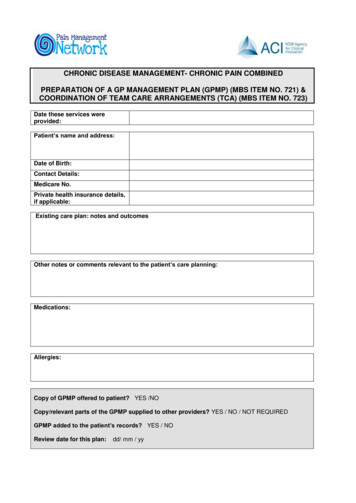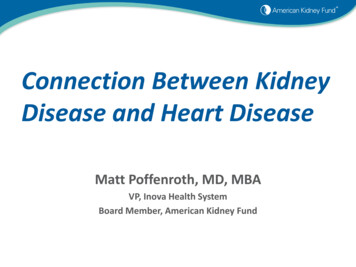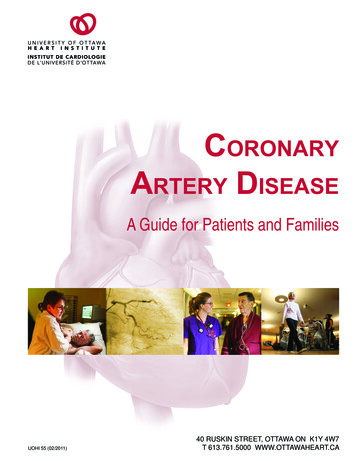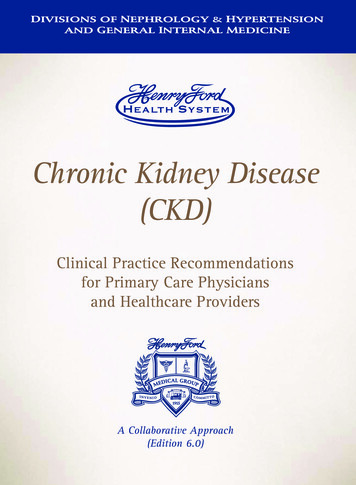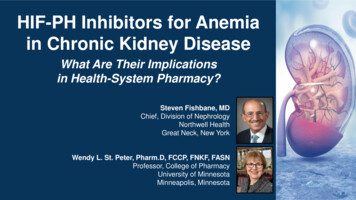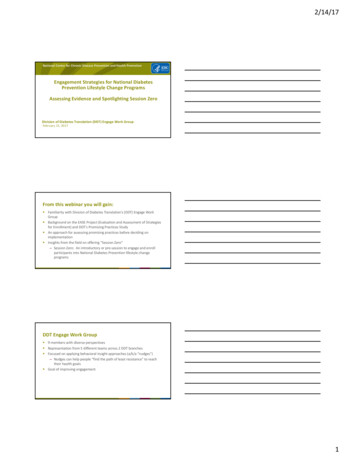
Transcription
2/14/17National Center for Chronic Disease Prevention and Health PromotionEngagement Strategies for National DiabetesPrevention Lifestyle Change ProgramsAssessing Evidence and Spotlighting Session ZeroDivision of Diabetes Translation (DDT) Engage Work GroupFebruary 15, 2017From this webinar you will gain:§ Familiarity with Division of Diabetes Translation’s (DDT) Engage WorkGroup§ Background on the EASE Project (Evaluation and Assessment of Strategiesfor Enrollment) and DDT’s Promising Practices Study§ An approach for assessing promising practices before deciding onimplementation§ Insights from the field on offering “Session Zero”– Session Zero: An introductory or pre-session to engage and enrollparticipants into National Diabetes Prevention lifestyle changeprogramsDDT Engage Work Group§ 9 members with diverse perspectives§ Representation from 5 different teams across 2 DDT branches§ Focused on applying behavioral insight approaches (a/k/a “nudges”)– Nudges can help people “find the path of least resistance” to reachtheir health goals§ Goal of improving engagement1
2/14/17Guidance for Assessing Evidence to HelpBridge the Gap Between Real and IdealKrista Proia, Engage Co-LeadExample of the real: Promising Practices Study§ Purpose: Identify and spread promising practices to increase enrollment inNational DPP lifestyle change programs– Telephone interviews with 9 CDC-recognized organizations, including: Program staff and participants 2 organizations offering virtual programs– Expert panel to review promising practices and seek new ideasStriving for the ideal: Evaluation and Assessment ofStrategies for Enrollment (EASE) Project§ Purpose: Develop, implement and evaluate an enrollment intervention toincrease participation in National DPP lifestyle change programs§ Multi-component intervention package:– Designed to reduce behavioral barriers across all stages in theenrollment process§ Controlled evaluation– Compare enrollment rates between sites implementing and notimplementing the EASE package– Including implementation feasibility & fidelity, retention, weight lossand cost§ Results expected: Early 20192
2/14/17Ideal World§§§§Pre/post intervention dataComparison groupAssessing unintended effectsAssessing costsReal World§§§§Nat’l Org. Eval.– some participantdata; no pre-implementation dataand no control groupPromising Practices Studies –stories with no dataEASE diagnosis report –evidencefrom different populations &purposesExpert panel – weak evidence &little consensusFramework for Thinking About evidenceDDT’s Hierarchy of Evidence for Best PracticesExample: National DPP§ Meta-Analyses of RCTs§ Randomized controlled trials (RCTs)Best§ Non-randomized, controlled intervention studies Example: EASE§ Meta-analyses of observational -§ Observational studiesPromising§ Uncontrolled evaluation of existing programs Example: 1212 Evaluation§ Anecdotal experience§ Intuition and common senseGregg E. Framework and Update on Best Practices for Prevention and Control of Diabetes. May 2010.3
2/14/17Components of Public Health ImpactSpencer LM et al. Seeking best practices: A conceptual framework. PCD. 2013;10Hierarchy of Evidence Relative to Impact ComponentsEvans D et al. Hierarchy of evidence: a framework for ranking evidence. JCN. 2003;12:77-84.US Preventive Services Task Force Hierarchy of Evidence Properly powered and conducted RCT Well conducted systematic review or meta-analysis of homogeneous RCTsIIIIIIII-1 Well-designed controlled trial without randomizationII-2 Well-designed cohort or case-control analysisII-3 Multiple time series, with or without the intervention Results from uncontrolled studies that yield results of large magnitude Opinions of respected authorities, based on clinical experience Descriptive studies or case reports Reports of expert committeesUSPSTF. 2015. U.S. Preventive Services Task Force Procedural Manual. /Name/methodsand-processes4
2/14/17Continuum of Research Evidence for Effectiveness§ CDC’s Injury Center’s framework– Uses continuum vs. hierarchy– Includes negative evidence, e.g., evidence for: Little or no effect HarmPuddy R et al. 2011. Understanding Evidence Part 1: Best Available Research Evidence.A Guide to the Continuum of Evidence of Effectiveness. Atlanta, GA: enceShort List of Questions to Consider BeforeImplementing a Promising Practice§ What level of evidence supports expected benefits?§ What scale of resources will be required?§ What could we do with these resources otherwise (i.e., what is theopportunity cost)?§ What are the potential unintended consequences or even harms?§ What may be the effects on disparities?§ What is the urgency to act?Example: Economic incentives Evidence for effectiveness is highly variedEffectiveness and cost depend on how and when cash is offered and paidPotentially very expensive at a population levelResources better spent on existing strategiesMonetary incentives can backfire5
2/14/17CDC’s Considerations in Spotlighting Session ZeroConsistent support across diverse sources of information:– National Organizations (1212) evaluation– Promising Practices and EASE interviews/site visits– EASE behavioral diagnosis and design results– Multiple behavioral experts§ Careful consideration of opportunity costs is still needed§ No major unintended consequences identified so far; continue to monitor§ Evaluation needed on differential impact by age, sex, race/ethnicity, income§Poll Question§ When thinking about/acting upon a “Framework for Thinking aboutEvidence,” what domain has the most influence on decision making for youand your key stakeholders?A. Contextual EvidenceB. Experimental EvidenceC. Best Available ResearchD. None of the aboveIf D was chosen, please specify why in the question box located in your controlpanelThank you!§ For more information contact:– Krista Proia, isp9@cdc.gov, 404.498.09616
2/14/17References§§§§§Evans D et al. Hierarchy of evidence: a framework for ranking evidence evaluating healthcareinterventions. Journal of Clinical Nursing. 2003;12:77-84.Gregg E. Framework and Update on Best Practices for Prevention and Control of Diabetes.May 2010.Puddy RW, Wilkins N. Understanding Evidence Part 1: Best Available Research Evidence. AGuide to the Continuum of Evidence of Effectiveness. Atlanta, GA: Centers for Disease Controland Prevention. 2011. Available rstanding evidence-a.pdf– Additional resources, including a Continuum of -evidenceSpencer LM et al. Seeking best practices: A conceptual framework for planning and improvingevidence-based practices. Preventing Chronic Disease. 2013;10.USPSTF. 2015. U.S. Preventive Services Task Force Procedural Manual. Available age/Name/methods-and-processesInsights From the FieldArt FrankeNational Kidney Foundation of Michigan7
2/14/17DPP Information SessionArt Franke, PhD2/15/2017Top Ten Reasons to do a Session Zero Educate about prediabetes and how to prevent type 2 diabetesBriefly describe science behind the Diabetes Prevention ProgramSet the tone of the lifestyle change program and describe its goalsAnswer potential participants’ questionsDetermine motivation level of potential participantsIdentify people with diabetes and offer alternatives (e.g., DSME, DSMP)Start connecting participants with each other and lifestyle coachObtain commitment and determine if everyone qualifies for the workshopFill out paperwork and enrollment materialsRecruit additional participants from their family and friends (if needed)Who is Invited to the Information Session?Held at same location, time& day as planned workshopReferrals fromInsurers, HostSites, andEmployersSession led by trainedlifestyle coachReferrals fromHealth CareProvidersGoal20-30PeopleReached byMarketingMaterialsWhoever is interested in learning moreabout attending a DPP workshop!Friends & Familyof PotentialParticipantsFrequency 1 or 2 depending on howmany people sign up!8
2/14/17How to Make People Aware with a Sense of UrgencyEngagement, Engagement, Engagement! Use multi-channel approach: Rally front-line health providers, insurers,community partners, employers, the public atlarge near workshop location Distribute workshop flyers at host sites, healthproviders, local churches, etc. Active marketing at events, on websites,newsletter, press releases, PSAs, mailings,flyers to community partners, social mediaInformational Session Agenda Introductions – Why are we here?What is the National Diabetes Prevention Program?Program GoalsWhy does it work?Demo DPP ActivityQualifying for the ProgramAre you ready?Full disclosureFill out registration packetDiscuss recruiting additional participantsLessons Learned – It’s Important to Have a Session 0Session 0 is very important to having a smoother Session 1It helps determine if everyone who enrolls is qualified and ready to goOpportunity to discuss other health benefitsSome people may not have made up their minds but connect withpeers or coach and/or get answers to additional questions Consider a testimonial (or video) from previous participant aboutsuccess in DPP and its impact on their life Address other barriers to participation in the DPP If workshop is not full, have additional flyers and request attendeesrecruit family and friends who might qualify 9
2/14/17Contact Information:Art Frankeafranke@nkfm.org734-222-9800Karen BaileyUniversity Medical AssociatesKaren Bailey, LD, CDE, MSUMA Diabetes & Endocrine Care/OUHCOM Diabetes InstitutePrevent T2 ProgramAthens, OhioLocated in rural Southeastern Ohio, home of OhioUniversityTrained as DPP Lifestyle Coach at University ofPittsburgh in 2012 and started Group LifestyleBalance January 2013Spring 2013 became a grantee of AmericanAssociation of Diabetes Educators and beganDiabetes Prevention Program classes using CDCcurriculum after being trained at DTTAC in AtlantaReceived CDC recognition January 2016. Started11th class this month. Using Prevent T2 curriculum10
2/14/17Objectives“Session Zero”ØPurpose it serves in our programUMA Diabetes & Endocrine Care/OUHCOM Diabetes InstitutePrevent T2 ProgramØHow we target individuals for the sessionØContent of the session in our programPurpose of Session ZerovDescribe the program in more detail than advertisements offervAnswer any questions prospective participants may havevDecrease incidence of drop outs by describing the commitment the program entailsvComplete and collect forms required by the programBefore Session Zero Advertisements for program are sent out between2 months and 2 weeks before the program starts.§§§§§Newspapers – classified ad, larger ads, on-line adsRadio announcementsEmployee newslettersWebsites, Facebook, TwitterFlyers distributed to doctor’s offices,libraries, Health Department, etc.11
2/14/17Before Session Zero Interested individuals eithercall or emailWe send them thefollowing info:Prevent T2A PROVEN PROGRAM TO PREVENT OR DELAY TYPE 2 DIABETESINFORMATIONAL SESSION:ARE YOU READY TO COMMIT?12
2/14/17Informational Session: Are You Ready toCommit? Agenda Introduce the Prevent T2 program and members of the team who will besupporting participants on their journey of lifestyle change this year. Review the Participation Agreement Form and if ready to commit, sign Become familiar with Session routine Complete and return consent, intake, Physician Referral and agreement formsPrevent T2Informational Session (session 0)Description of the DPP Study Results – Power of lifestyle change Benefit to all, no matter gender, race or ethnicity and even greater benefit forthose over 60 yrs of age Impact that lifestyle change may have in reducing the overwhelming burdenof diabetes on health care costs in U.S.Prevent T2Informational SessionDescription of National Diabetes Prevention Program Effort to duplicate these results in communities across the nation Delivered to groups Economically feasible The added benefit of group support Approved curriculum, recognition status, program support De-identified data submission to CDC to evaluate effectiveness of program13
2/14/17Prevent T2Informational SessionMust be 18 yrs old with a BMI 24 kg/m² ( 22 kg/m², if Asian) 50% must have diagnosis of pre-diabetes using the following recent bloodtests (within past year):§ Fasting plasma glucose of 100-125§ Plasma glucose 2 hr after 75 gm glucose load of 140-199 mg/dl§ A1c of 5.7-6.4§ Clinically diagnosed Gestational diabetes mellitus during previouspregnancy (may be self reported)50% max may be eligible without blood test or hx of GDM if they screenpositive using Pre-diabetes Screening Test.Pre-diabetes Screening TestPrevent T2Informational SessionCohorts completed with weight loss resultsJan, 2013(6%)May, 2013(5%)Sept, 2015 – 2 cohortsAthens (7%), Marietta (7%)Sept, 2013 (6%)Jan 2016 (5%)Jan, 2014Jan, 2015Sept, 2016Jan 2017(14%)(8%)14
2/14/17Prevent T2Informational Session}Participants attend 90 minute weekly meetings for 12 weeks, bi-weekly for 8weeks, then monthly meetings for remainder of year.}Participants will weigh in at each visit, track food, calorie and fat gram intake andrecord daily. These diaries will be collected and reviewed by lifestyle coaches andreturned with helpful comments and praise. Participants will be given weeklyassignments to bring and discuss with other participants.}Lifestyle coaches will present material weekly on healthy eating, ways to increasephysical activity and behavior change strategies and provide positivereinforcement to allow participants to overcome obstacles and change lifestylehabits in favor of eating less and moving more. Sessions are interactive with groupdiscussion and activities.Prevent T2Informational Session (session 0)Session Routine: Weigh in and record on your weight record Turn in completed food and activity trackers; declare minutes of activity forprevious week and pedometer steps when you get pedometers Collect session materials, new trackers and goal sheets Try the recipe of the day and get copy of recipe to try at home! Dress comfortably for light to moderate paced exercisePrevent T2Informational SessionINCENTIVESFirst 6 months –Participants who attend 80% of the sessions (13) on the scheduleddate, making up any missing sessions by the end of the Core Sessions (Session 16) andbring Food and Activity Trackers completed 80% of the time will receive an incentive.The incentive will be something that supports a healthy lifestyle.Second 6 months – Raffles: show up for session, enter raffle; bring completed tracker,get another raffle. Winner gets prize at end of session.Pedometer challenges – group walks around the U.S. Individuals with highestpedometer steps recognized.15
2/14/17Prevent T2Informational SessionCost of year-long program: 500The Athens County Health Department and the AADE isproviding scholarships for individuals who have pre-diabetes. Pay 100 at the beginning of program and receive it back if 80% ofprogram is completed.Certain employers may pay for program: UMA, OUOU employees – pay 100 up front and get this back if complete80% of programUMA – If pt does not complete 80% of program, pt pays forprogram costs.Prevent T2Informational Session (session 0)Read, sign and turn in forms:üPhysician Referral formüParticipant agreement formüProgram intake formüFitness questionnaireüConsent forms for:ØSharing contact information with the group and staffØAllowing photos of self during the programØWaiver form for exercise16
2/14/17Prevent T2Informational SessionLessons LearnedSession Zero is helpful vClarify program commitment and hopefully decrease incidence of drop-outsvMake sure participants have received, completed and turned in needed formsv Everyone has heard the same message; all hopefully on same page.vAllows more time first session for content and ice breaker activities.17
2/14/17Lessons learned, observations made (anecdotal)ØOptimal size of group – 10 to 15. There will be drop outs; if starting too small, not enoughenergy in the group. Too large, and group intimacy is sacrificed.ØSuccess for participant is inversely correlated to the complexity of one’s life§ Full time jobs and responsibility of children or elderly parents are challenges to staying in program§ Financial challenges, health problems, lack of support are also challenges§ Lack of confidence, failed attempts at dieting, eating disorders present challengesØ Retired individuals or those that have more time and fewer responsibilities for others dobetter.Ø Attention to attendance and tracking are indicators of success.Ø Couples participating together in program can be helpful, although less likely to happen.Ø Those who have already started the process of change before coming to program do better.Kimberly LoveladyFundamental Health Solutions18
2/14/1719
2/14/17Questions and DiscussionPoll QuestionBased on what you have heard today, do you plan to implement a SessionZero?A. YesB. NoC. Need more information to decideIf C was chosen, please specify what information you need in the question boxlocated in your control panel.20
2/14/17For more information, contact CDC1-800-CDC-INFO (232-4636)TTY: 1-888-232-6348 www.cdc.govThe findings and conclusions in this report are those of the authors and do not necessarily represent theofficial position of the Centers for Disease Control and Prevention.21
–Session Zero: An introductory or pre-session to engage and enroll participants into National Diabetes Prevention lifestyle change programs . (a/k/a “nudges”) –Nudges can help people “find the path of least resistance” to reach their health goals § Goal of improving enga







